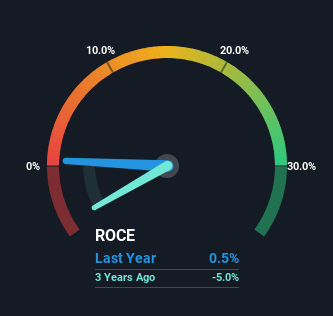There Are Reasons To Feel Uneasy About Australian Agricultural Projects' (ASX:AAP) Returns On Capital
Finding a business that has the potential to grow substantially is not easy, but it is possible if we look at a few key financial metrics. Firstly, we'd want to identify a growing return on capital employed (ROCE) and then alongside that, an ever-increasing base of capital employed. If you see this, it typically means it's a company with a great business model and plenty of profitable reinvestment opportunities. Having said that, from a first glance at Australian Agricultural Projects (ASX:AAP) we aren't jumping out of our chairs at how returns are trending, but let's have a deeper look.
Return On Capital Employed (ROCE): What Is It?
For those who don't know, ROCE is a measure of a company's yearly pre-tax profit (its return), relative to the capital employed in the business. To calculate this metric for Australian Agricultural Projects, this is the formula:
Return on Capital Employed = Earnings Before Interest and Tax (EBIT) ÷ (Total Assets - Current Liabilities)
0.0048 = AU$74k ÷ (AU$19m - AU$3.6m) (Based on the trailing twelve months to December 2022).
Therefore, Australian Agricultural Projects has an ROCE of 0.5%. In absolute terms, that's a low return and it also under-performs the Food industry average of 3.9%.
View our latest analysis for Australian Agricultural Projects
Historical performance is a great place to start when researching a stock so above you can see the gauge for Australian Agricultural Projects' ROCE against it's prior returns. If you're interested in investigating Australian Agricultural Projects' past further, check out this free graph of past earnings, revenue and cash flow.
What Does the ROCE Trend For Australian Agricultural Projects Tell Us?
On the surface, the trend of ROCE at Australian Agricultural Projects doesn't inspire confidence. Over the last five years, returns on capital have decreased to 0.5% from 3.7% five years ago. Given the business is employing more capital while revenue has slipped, this is a bit concerning. This could mean that the business is losing its competitive advantage or market share, because while more money is being put into ventures, it's actually producing a lower return - "less bang for their buck" per se.
Our Take On Australian Agricultural Projects' ROCE
We're a bit apprehensive about Australian Agricultural Projects because despite more capital being deployed in the business, returns on that capital and sales have both fallen. It should come as no surprise then that the stock has fallen 49% over the last five years, so it looks like investors are recognizing these changes. That being the case, unless the underlying trends revert to a more positive trajectory, we'd consider looking elsewhere.
Australian Agricultural Projects does come with some risks though, we found 6 warning signs in our investment analysis, and 3 of those are a bit unpleasant...
If you want to search for solid companies with great earnings, check out this free list of companies with good balance sheets and impressive returns on equity.
Have feedback on this article? Concerned about the content? Get in touch with us directly. Alternatively, email editorial-team (at) simplywallst.com.
This article by Simply Wall St is general in nature. We provide commentary based on historical data and analyst forecasts only using an unbiased methodology and our articles are not intended to be financial advice. It does not constitute a recommendation to buy or sell any stock, and does not take account of your objectives, or your financial situation. We aim to bring you long-term focused analysis driven by fundamental data. Note that our analysis may not factor in the latest price-sensitive company announcements or qualitative material. Simply Wall St has no position in any stocks mentioned.

